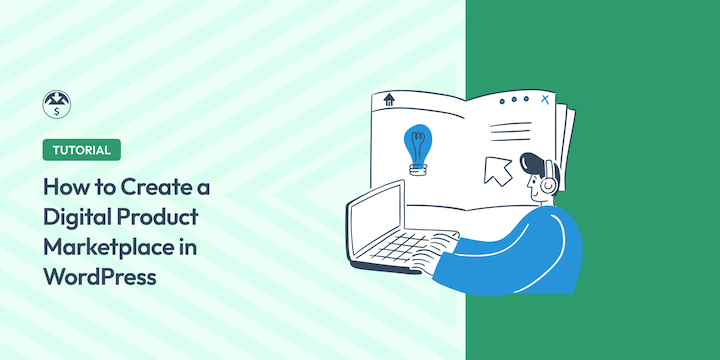
Have you ever dreamed of creating your own digital product marketplace where you and other creators can sell digital goods? There’s never been a better time to do it.
There are over 2 billion digital buyers worldwide and the digital product market is expected to reach over $331 billion by 2030.
But where do you even begin? I get it. You might picture complicated coding, sky-high development costs, and a mountain of technical jargon. I understand the challenges you face — from choosing the right platform to attracting both sellers and buyers.
That’s where this guide comes in. I’ll walk you through exactly how to create a thriving digital marketplace using WordPress.
🔎 I’ll cover:
What Is an Online Product Marketplace?
A digital products marketplace is an online platform where multiple vendors can list and sell digital products online. The website or app connects creators and sellers of digital products with potential customers.
Think of it like Amazon or Etsy, but specifically for digital goods and downloadable items such as:
- eBooks and PDF guides
- Online courses and educational content
- Digital art and graphics
- WordPress themes and plugins
- Music and audio files
- Software and apps
- Templates and printables
Essentially, anything that can be delivered electronically can be sold in a digital marketplace.
Benefits of Digital Marketplaces
💡 Key Benefit: Unlike physical product marketplaces, digital marketplaces have minimal overhead costs since there’s no inventory to store or shipping to manage.
Creating a digital marketplace is a great way to generate passive income, build a community, and empower others to share their talents. The benefits of a digital marketplace are twofold, benefiting both sellers and buyers.
For business owners and developers, the pros of selling on a digital marketplace far outweigh the cons of selling on one. There are just as many benefits for customers.
| Sellers | Customers |
|---|---|
| 💰Passive income through commission fees. Once a digital product is created and uploaded, it can be sold repeatedly with minimal ongoing effort, generating a stream of passive income. | ✅ Convenience. Customers can find a wide variety of digital products in one convenient location, saving time and effort compared to searching individual websites. |
| 🌐 Wider audience reach. Marketplaces expose sellers’ products to a much larger audience than they might reach on their own. There’s scalability without additional infrastructure and global reach without geographical limitations. | 💻 Instant access. Digital products are typically available for instant download after purchase, providing immediate gratification. Automated delivery systems save time for both parties. |
| 📣 Marketing and promotion. Many marketing tools and promotional opportunities to help sellers boost their product visibility. | 🏷 Competitive pricing. The presence of multiple sellers often leads to competitive pricing, giving customers more choices and better deals. |
While there are third-party platforms to sell digital downloads and popular digital products (think Creative Market, Etsy, etc.), creating your own digital marketplace offers significant advantages. You have complete control over branding, pricing, and customer relationships. You also avoid paying hefty commissions to third-party platforms, keeping more of your earnings.
Why Use WordPress for Online Marketplaces?
Building a successful and profitable digital products marketplace requires several key components. This includes a:
- Vendor management system to submit and manage products.
- User-friendly online store with shopping cart functionality to showcase products.
- Secure and reliable way to accept and process online payments.
- Robust user account management and download delivery system.
While various platforms can help you achieve this, WordPress stands out as a particularly powerful and versatile solution.
💡 WordPress powers over 43% of all websites, making it a trusted platform with extensive documentation and support. It offers several distinct advantages for creating a digital marketplace.
- Flexibility. WordPress is incredibly flexible, allowing you to customize virtually every aspect of your marketplace to match your specific needs.
- Vast plugin ecosystem. The extensive library of WordPress plugins provides readily available solutions for almost any functionality you can imagine, from vendor management and payment gateways to marketing tools and customer support features.
- Cost-effectiveness. Compared to custom development or other platform options, WordPress offers a more affordable way to build a fully functional marketplace with lower developmental and maintenance costs.
- Ease of use. WordPress is known for its user-friendly interface. It’s approachable for beginners and satisfies the most advanced users and developers with its infinite customization possibilities. There’s also plenty of community support and access to developers and resources.
- Scalability and security. WordPress can scale with your business as it grows, handling increasing traffic and product volume. Regular updates and robust security features ensure sensitive data is protected.
With WordPress, you can create the best digital product marketplace regardless of your eCommerce niche. some of the popular types of marketplaces to sell digital products include:
- Stock photography and video sites
- Digital art, templates, and themes
- Online course and eBook platforms
- Music, audio, and sound effects
- Software, apps, and plugins
WordPress Plugins for Digital Marketplaces
WordPress itself doesn’t include eCommerce functionality out of the box. To transform your self-hosted WordPress website into a thriving digital marketplace, you’ll need the help of powerful plugins.
These plugins add the essential features required to manage products, process payments, handle customers, and create a seamless buying and selling experience.
Several plugins can help you create a marketplace. But a few stand out for their robust features and ease of use. Each offers a unique set of functionalities, and the best choice depends on the specific needs of your marketplace.
Easy Digital Downloads (EDD)
For creating a dedicated digital products marketplace, Easy Digital Downloads (EDD) is the ideal choice.

EDD is specifically designed for selling digital goods. With lightweight and fast performance, EDD offers a simplified and optimized experience for both sellers and buyers. It handles everything from product delivery and payment processing to customer management and discount codes, all within a clean and intuitive interface.
🔑 Key Features
Here’s a closer look at why EDD is the top recommendation for digital marketplaces.
Streamlined digital product management. EDD makes it incredibly easy to upload, manage, and categorize digital products. You can set prices, create variations, offer file downloads, and track sales all in one place.
Multiple payment gateways. EDD integrates seamlessly with popular payment gateways like PayPal and Stripe, allowing you to accept payments from customers worldwide.
Secure file delivery and flexible licensing system. EDD ensures secure delivery of your digital products, protecting your content from unauthorized access.
Customer management. EDD provides tools to manage your customer base, track purchase history, and offer personalized support.
Extensive extensions. The power of EDD can be further extended through a wide range of extensions. These add-ons can enhance your marketplace with features like recurring subscriptions, affiliate programs, advanced reporting tools, email marketing integrations, and much more. This allows you to tailor your marketplace to your specific needs as you grow.
Other Plugin Options
WooCommerce, while powerful and versatile, is often geared towards physical products, making it less streamlined for purely digital marketplaces. It can be adapted, but it requires more configuration and potentially additional extensions.
For instance, this includes extensions for product vendors, digital downloads, and subscription capabilities.
Alternative extensions include:
- WC Vendor
- YITH WooCommerce Multi-Vendor/Marketplace
- MultiVendorX
💡If you’re purely selling digital products, Easy Digital Downloads is more streamlined and efficient. However, if you also plan to sell physical goods, WooCommerce is an alternative worth considering.
How to Create a Digital Product Marketplace
Now that we’ve covered the essentials, let’s dive into the step-by-step process of creating your digital product marketplace in WordPress. The following sections will guide you through each stage, from installing the necessary plugins to configuring your marketplace and adding your first products.
This tutorial assumes you already have a WordPress website up and running. If you already have a WordPress site and are familiar with Easy Digital Downloads, feel free to skip ahead to Step 2.
Don’t have a WordPress site yet?
Setting up a WordPress site involves choosing and registering a domain name (your website’s address), selecting a WordPress hosting provider (where your website files will live), and installing WordPress.
To make this process as quick and painless as possible, I recommend SiteGround’s Managed EDD hosting.
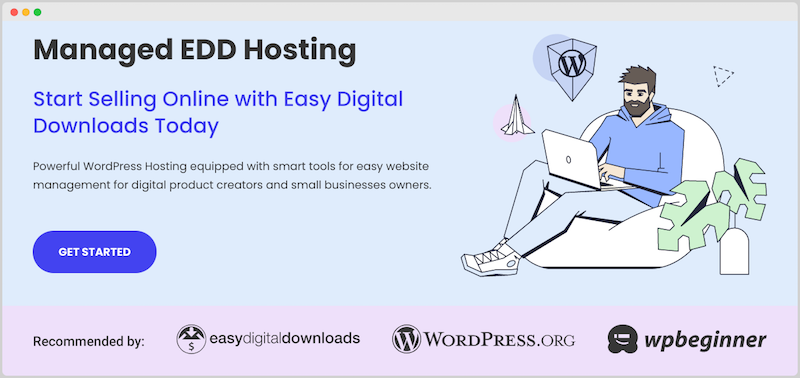
SiteGround’s specialized hosting is optimized for Easy Digital Downloads, ensuring your marketplace runs smoothly and efficiently.
You’ll get everything you need to create an online store in WordPress and start selling digital products in no time. This includes WordPress pre-installed, Easy Digital Downloads core plugin, enhanced security features, and so much more.
Step 1. Install Easy Digital Downloads
Easy Digital Downloads is the heart of your digital marketplace. It provides all the core functionality you need to sell and manage your digital products.
To unlock the full potential of EDD for creating a marketplace, you’ll need a Professional or All Access Pass. These passes provide access to the essential features and extensions required for multi-vendor marketplaces, product submissions, and more.
Visit the Easy Digital Downloads website and choose the Professional or All Access Pass.
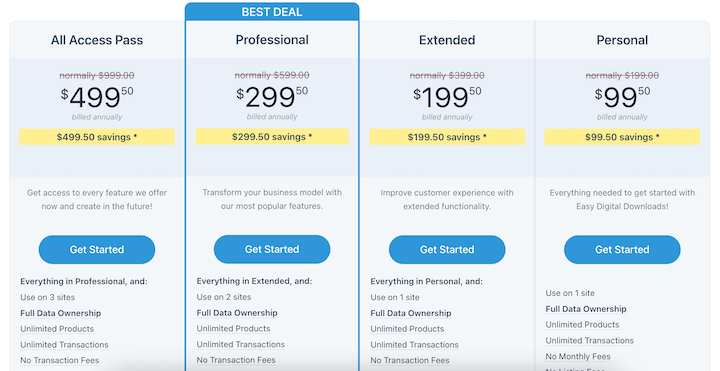
Once your purchase is complete, you can download the EDD Pro plugin zip file from your EDD account dashboard.

Next, from your WordPress dashboard, navigate to Plugins » Add New Plugin. Click on Upload Plugin » Choose File. Select the EDD Pro plugin zip file you downloaded. Then click on Install Now and Activate Plugin.

After activating the plugin, a Downloads menu item will be added to your admin area.
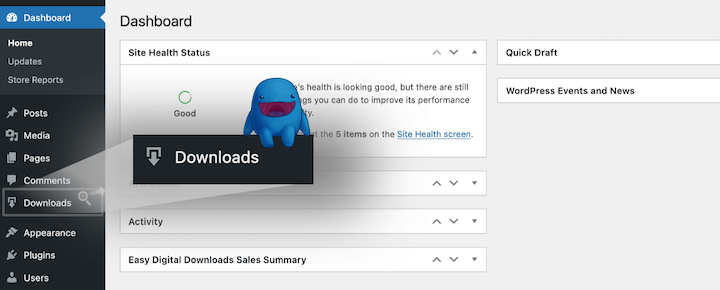
You can select Get Started to launch the setup wizard. This wizard will walk you through the initial configuration of your EDD site.
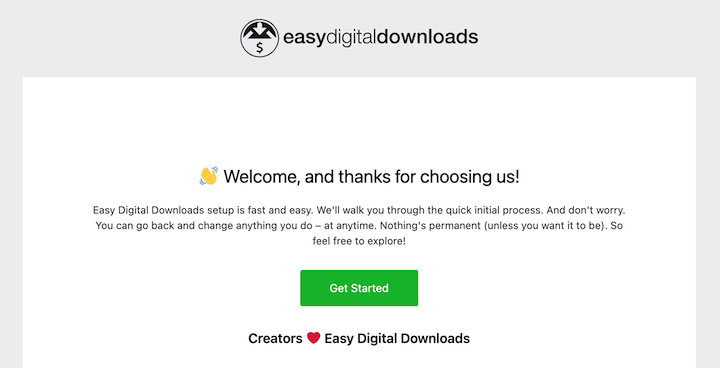
You’ll be prompted to set up and connect the Stripe payment gateway, configure essential store settings like currency and tax, and add your first digital product.
⚙️ Feel free to refer to our EDD Quickstart Guide or follow the below setup video for step-by-step guidance.
Step 2. Add Marketplace Extensions
With EDD installed and configured, the next step is to add the essential extensions that will transform your basic EDD setup into a full-fledged online marketplace. Two key extensions are needed for this: Frontend Submissions (FES) and Commissions.
Frontend Submissions (FES)
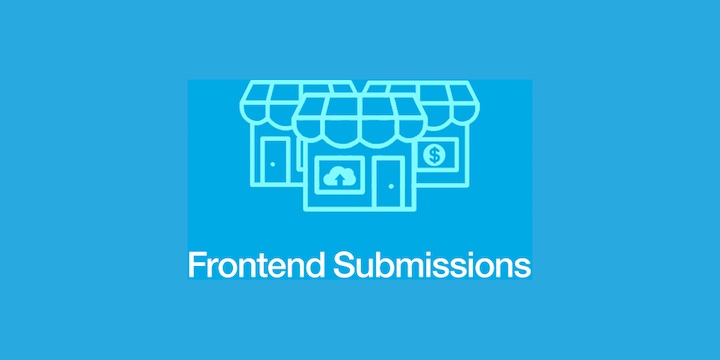
FES allows vendors to submit and manage their products directly from the front end of your website, without needing access to the WordPress admin area. This is essential for creating a true multi-vendor marketplace where sellers can control their own listings.
Commissions
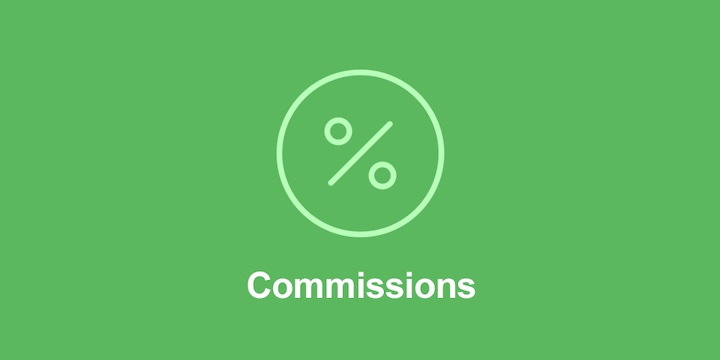
Commissions enables you to automatically calculate and distribute commissions to your vendors for each sale. You can set commission rates based on a percentage or fixed amount, and the system will handle the payouts seamlessly.
To enable these extensions, go to Downloads » Extensions. There will be a list of downloadable addons. Locate the FES extension and click on Install. Then do the same for Commissions.
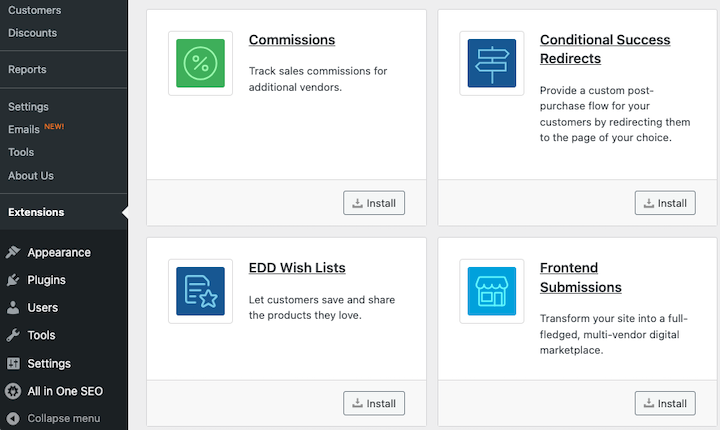
The extensions activate automatically.
Step 3. Configure Vendor & Commissions Settings
With the essential extensions installed, it’s time to fine-tune the settings that govern your vendor interactions and commission payouts. This step is crucial for creating a smooth and profitable experience for both you and your vendors.
Vendor Dashboard
The FES extension provides the foundation for your vendor dashboard, empowering sellers to manage their products and track their performance. Here’s how to configure it.
In your WordPress admin area, navigate to Downloads » Settings » FES.

Within these Main Settings, you can customize the welcome or announcement message displayed on the vendor dashboard. This is a great way to communicate important updates, promotions, or guidelines to your sellers.
You can also configure the Forms/Pages.
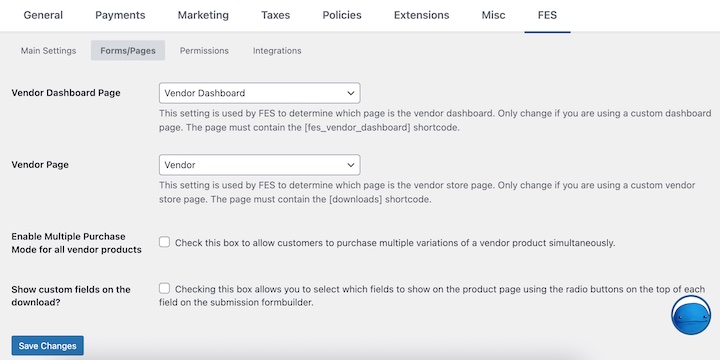
When a vendor logs in, they’ll have access to their dedicated Vendor Dashboard. They can perform a handful of functions.

Under the Products table, they can view and manage their submitted products.
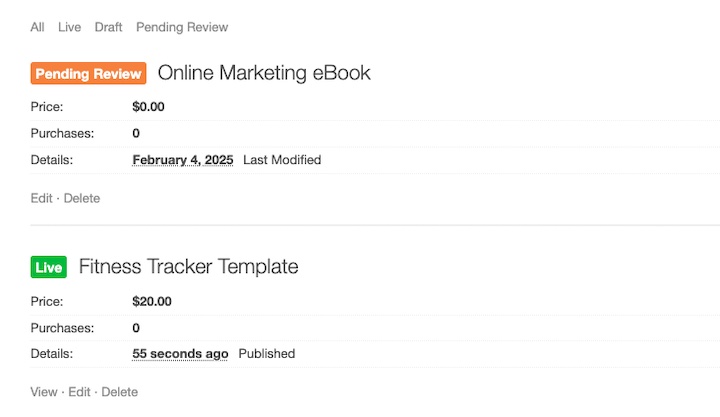
They can click the + Add Product button to access the submission form.

The Earnings tab is where they track their sales and earnings.

Vendors can see details of individual orders under Orders. They can edit their profile settings under Profile.
Vendor Submission & Approval Process
The core of FES is the product submission workflow. Here’s how it works.
When the vendor logs into their dashboard, they can access the submission form under + Add Product.
The submission form typically includes fields for the product title, description, and any other relevant information. You can customize these fields to match your specific needs under Downloads » Vendor Forms » Submission Form.
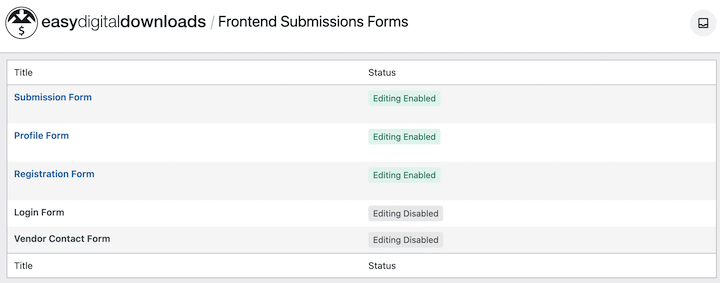
The vendor fills out the form and submits it.
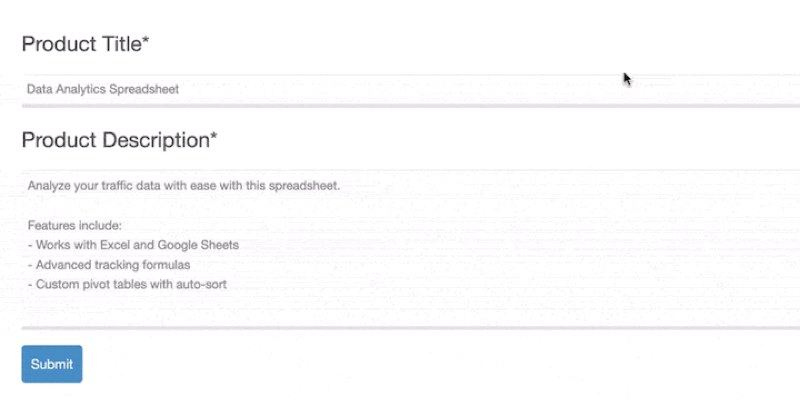
Submitted products will appear in your WordPress admin area under Downloads » All Downloads with a “Pending Review” status.
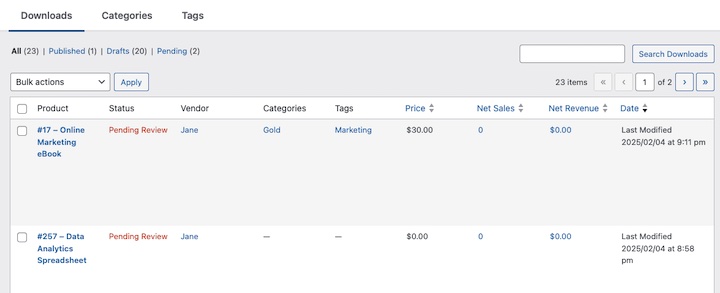
You have two options for approving:
- Hover over the product name and click the Approve button.
- Click the product name to review the details, make any necessary edits (including price, download image, or other download settings), and then approve.
Vendors will typically receive email notifications when their products are submitted, approved, or rejected.
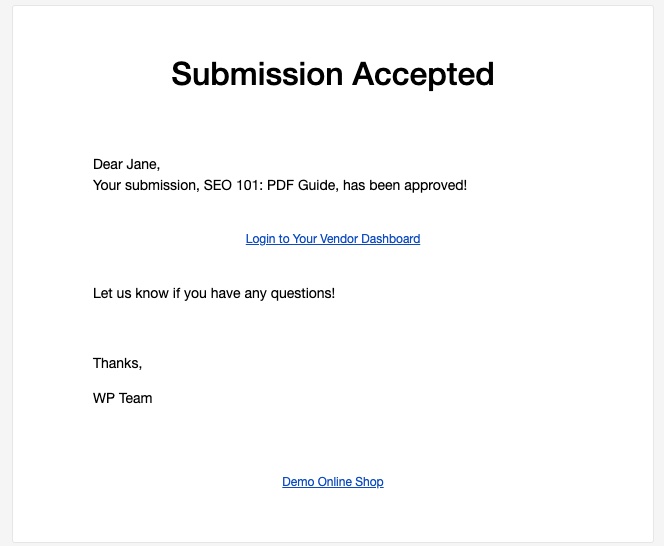
I’ll cover how to customize these emails in the next section.
⚙️ Feel free to refer to our Frontend Submissions documentation for additional help.
Commissions Settings
Commissions are the lifeblood of your marketplace, ensuring that your vendors are fairly compensated for their contributions.
To get started, go to Downloads » Settings » Extensions » Commissions.
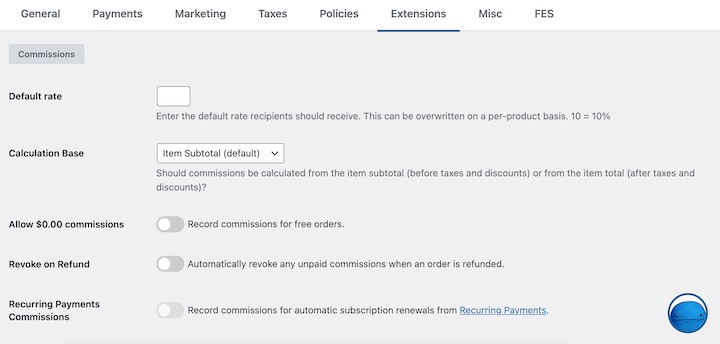
The most important setting here is the commission rate (Default rate). This is the percentage — or fixed amount — that vendors receive for each sale. The default is often 60%, but you can adjust this based on your business model.
Explore the other commission settings to fine-tune how commissions are calculated and paid out.
You can track all commission payments under Downloads » Commissions. This section will show you which commissions have been paid, are pending, or are due.
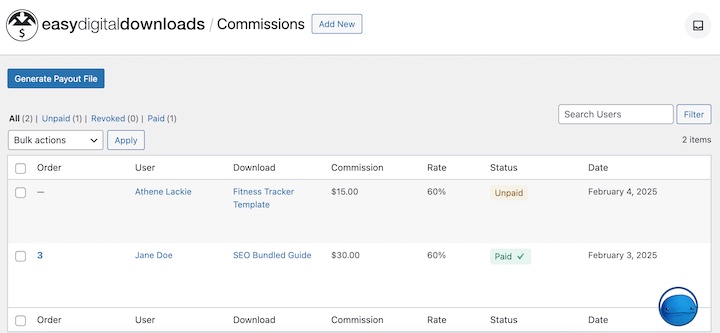
⚙️ Feel free to refer to our Commissions setup documentation for additional guidance.
Step 4. Customize Your Marketplace Emails
Running a virtual marketplace involves a lot of moving parts, and communication is key.
Numerous automated emails are essential for keeping everyone informed and ensuring a smooth experience. From vendor applications and product submissions to sales notifications and commission updates, automated email solutions are crucial for managing your marketplace efficiently.
Here’s a glimpse at the types of automated emails you’ll likely need:
- Vendor Application: Notifying you (the site owner) of new vendor applications.
- New Product Submission: Alerting you to new products submitted by vendors.
- Application Received: Confirming to vendors that their application has been received.
- Application Approved/Declined: Informing vendors about the status of their application.
- Submission Approved/Declined: Notifying vendors about the status of their product submissions.
- New Sale Notification: Alerting you and the vendor about a new sale.
- Commission Payout Notification: Informing vendors about commission payouts.
- Order Confirmation: Sending order confirmations to customers.
Trying to handle all these communications manually would quickly become overwhelming. Fortunately, Easy Digital Downloads makes it significantly easier.
Customizing Vendor Emails
Frontend Submissions handles many of the crucial emails related to vendor interactions. Under Downloads » Emails » Frontend Submissions, you’ll see a list of email templates related to various FES events (e.g., new vendor application, product submission, approval, rejection, etc.).
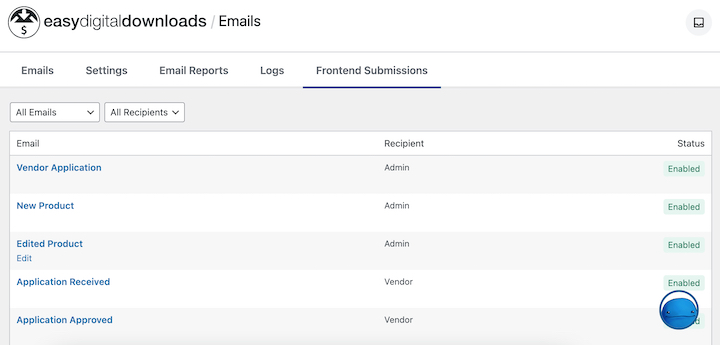
Click on the email template you want to customize. You’ll be able to edit the email subject, heading, and body content.
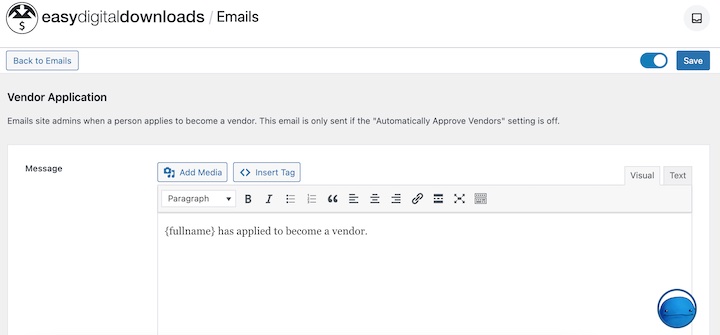
FES uses template email smart tags that allow you to dynamically insert information into the emails, such as vendor names, product titles, and application statuses.
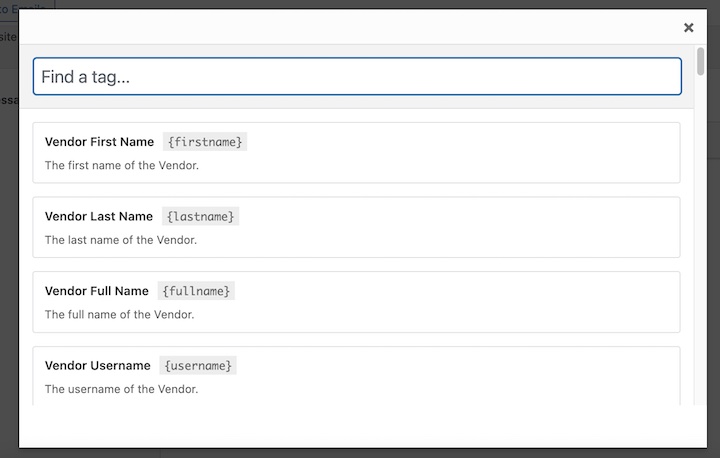
Refer to the FES documentation for a complete list of available template tags.
Depending on your theme, you may also be able to customize the visual design of the emails.
Before saving your changes, preview the email to ensure it looks correct. It’s also a good idea to send a test email to yourself to verify that it’s working as expected.
Customizing Commissions Notifications
The Commissions extension also generates important email notifications. To access the Commissions email settings, go to Downloads » Emails.
You’ll find email templates for commission-related events, such as new commission earned or commission payout.

Click on the email template you want to customize. You can edit the subject, heading, and body.
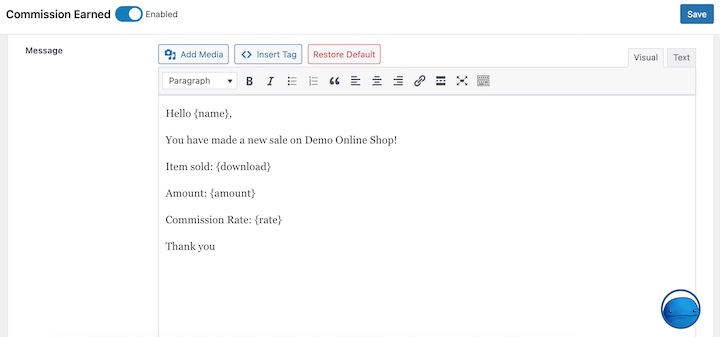
Similar to FES emails, Commissions notifications also use template tags. These tags let you personalize the emails with information like commission amounts, product names, and payout dates.
Always preview your email templates and send test emails to ensure they’re configured correctly.
By customizing these email notifications, you can create a professional and informative communication system that keeps your vendors and customers engaged and satisfied. Clear and timely communication is essential for building trust and fostering a thriving marketplace community.
Step 5. Customize Your Marketplace Design
The design of your online marketplace is the first impression you make on potential customers and vendors. A user-friendly and visually appealing design is crucial for attracting visitors, encouraging sales, and building a strong brand identity.
Think of your marketplace as a physical store – you want it to be inviting, easy to navigate, and reflective of the quality of products you offer.
Here are some key tips for customizing your marketplace design.
Choose a Suitable Theme
Select a WordPress theme that’s specifically designed for digital product marketplaces or eCommerce in general. These themes often come with pre-built layouts and features that are optimized for showcasing and selling digital goods. A good theme will make your marketplace look professional and easy to use.
I recommend checking out the Vendd WordPress theme, which is designed specifically for digital product marketplaces and integrates seamlessly with Easy Digital Downloads. It’s perfect for integrating with FES.
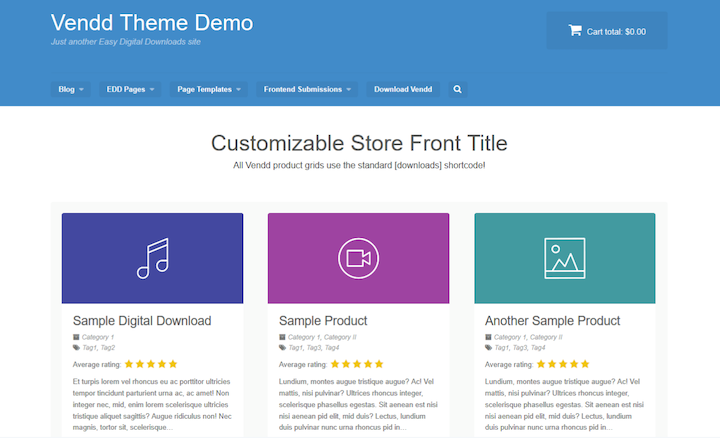
Other options exist, so explore themes specifically built for selling digital products. You can find WordPress themes in the WordPress Theme Directory or from premium theme marketplaces like ThemeForest.
To install a theme, go to Appearance » Themes from your WordPress admin area. Then select Add New Theme. You can either search for a theme or upload a zip file if you’ve purchased a premium theme.
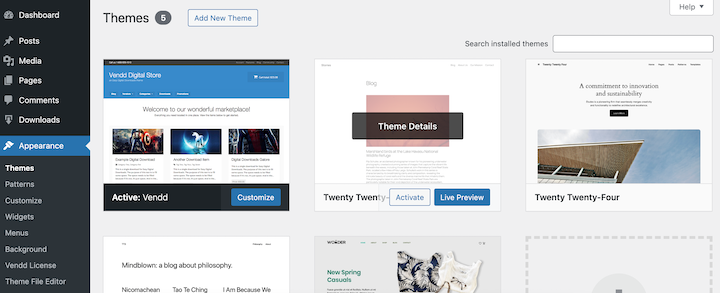
Once the theme is activated, go to Appearance » Customize to access the theme customizer. Here, you can change colors, fonts, layouts, and other design elements to match your brand and preferences.
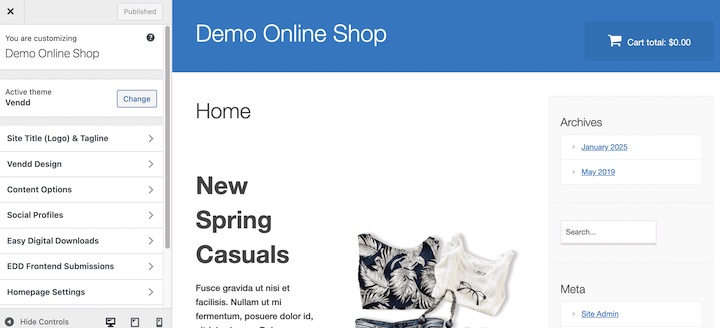
Additional Tips
There are a few other tips to keep in mind when designing and customizing your marketplace site.
- Match your brand. Customize the theme to match your brand’s colors, fonts, and overall style. This will create a consistent and recognizable identity for your marketplace.
- Focus on the user experience (UX). Prioritize a clean and intuitive layout that makes it easy for visitors to find what they’re looking for. Clear navigation, prominent search bars, and well-organized product categories are essential.
- Showcase your products. Use high-quality images and compelling descriptions to highlight your digital products. Consider using product demos or previews to give potential customers a better sense of what you offer.
- Ensure a mobile-friendly design. Ensure your marketplace is fully responsive and looks and functions great on all devices, including smartphones and tablets.
By carefully choosing and customizing your theme, you can create a digital products marketplace that is not only functional but also visually appealing and reflective of your brand’s unique identity.
Step 6. Market & Promote Your Digital Marketplace
Building a beautiful and functional marketplace is just the first step. To truly succeed, you need to attract both sellers (vendors) and buyers (customers).
You do this by implementing strategic ways to market your digital products. Effective marketing is essential for driving traffic, generating sales, and building a thriving marketplace community.
Here are some key marketing strategies to consider.
Search Engine Optimization (SEO)
Optimizing your marketplace for search engines is crucial for attracting organic traffic. Focus on relevant keywords related to your niche and the types of digital products you offer. Use descriptive product titles and descriptions, and ensure your website is mobile-friendly.
Plugins like AIOSEO can help you optimize your website’s SEO.
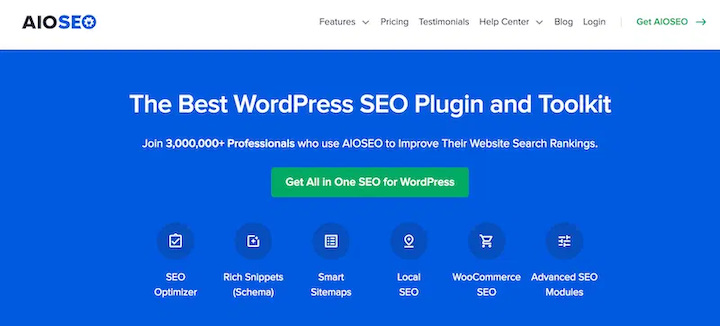
Social Media Marketing
Social media platforms are great for building brand awareness and engaging with potential customers and vendors. Share valuable content, promote your products, and run targeted advertising campaigns. Use visually appealing graphics and videos to capture attention.
Email Marketing
Building an email list allows you to directly communicate with your audience. Offer exclusive deals, announce new product releases, and share valuable content related to your niche.
Tools like OptinMonster can help you grow your email list. You can use it to create exit-intent pop-ups and other site elements that help with lead generation and conversion optimization.
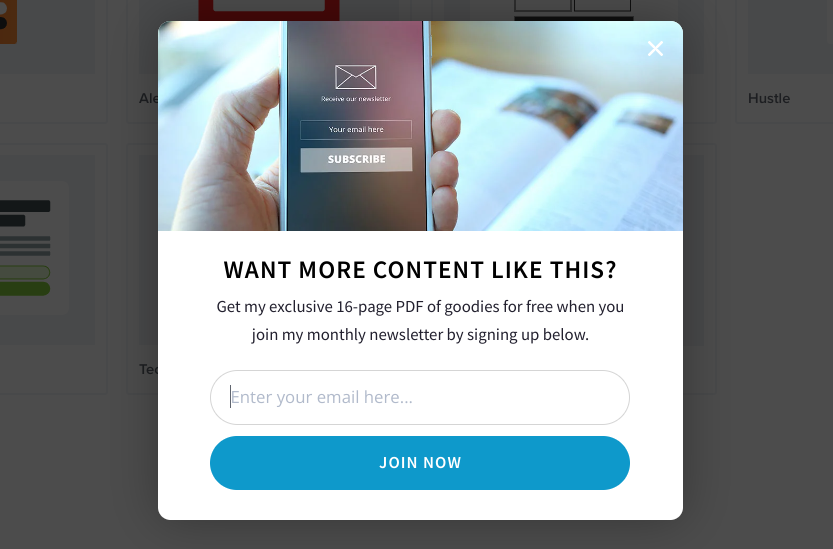
Affiliate Marketing
Recruiting affiliates to promote your marketplace can significantly expand your reach. Offer attractive commission rates to incentivize affiliates to drive traffic and sales to your platform.

AffiliateWP is a powerful plugin for managing affiliate programs.
Content Marketing
Content marketing is a powerful, cost-effective way to expand your reach. Creating valuable content related to your niche can attract and engage potential customers and vendors. Blog posts, tutorials, and guides can establish you as an authority in your field and drive organic traffic to your marketplace.
Tips for Managing a Digital Product Marketplace
Building a successful digital product marketplace is an ongoing process. Effective management is crucial for maintaining a smooth operation, fostering positive relationships with your vendors and customers, and ensuring the long-term growth of your platform.
💡 For optimal marketplace success:
- Create clear vendor guidelines
- Implement quality control measures
- Offer competitive commission rates
- Provide excellent vendor support
- Maintain regular communication
Here are some essential aspects of marketplace management and how Easy Digital Downloads can simplify the process.
Customer support
Providing excellent customer support is paramount. Respond promptly to inquiries, address concerns effectively, and go the extra mile to ensure customer satisfaction. EDD integrates with various help desk and support plugins, making it easier to manage customer communication.
Processing Refunds
Refunds are sometimes inevitable. Having a clear and fair refund policy is essential for building trust with your customers. EDD simplifies refund processing by allowing you to easily issue refunds through your connected payment gateways. You can also automate refund notifications to keep customers informed.
Managing Disputes
Disputes can arise from time to time. Having a well-defined dispute resolution process is crucial. EDD’s order management system provides a clear record of all transactions, which can be helpful in resolving disputes. Clear communication with both the customer and the vendor is key to reaching a fair resolution.
Monitoring Performance Metrics
Tracking key performance metrics is essential for understanding the health and growth of your marketplace. Monitor metrics like sales volume, conversion rates, customer acquisition cost, and average order value.
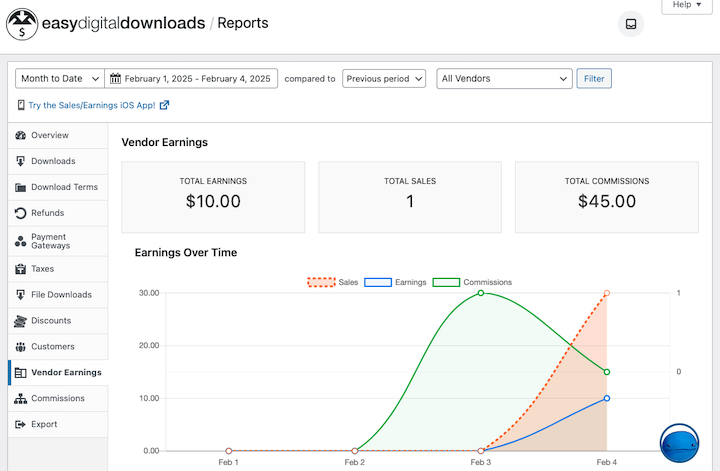
EDD provides built-in reporting features that give you insights into your sales data. You can also integrate EDD with analytics tools like MonsterInsights to connect Google Analytics to gain a deeper understanding of your marketplace’s performance.
Vendor Management
Maintaining good relationships with your vendors is vital. Provide them with the tools and resources they need to succeed, and communicate with them regularly.
EDD’s Frontend Submissions extension makes vendor management easier by allowing vendors to manage their products, track their earnings, and access sales reports.
FAQs on Creating a Digital Product Marketplace
Let’s wrap up with some frequently asked questions related to starting a digital product marketplace.
What is a digital product marketplace?
A digital marketplace is an online platform that connects creators and sellers of digital products online with potential customers. It’s a centralized hub where users can buy and sell downloadable goods like eBooks, software, templates, music, and more.
What are the best plugins for creating a marketplace?
While several plugins can be used, Easy Digital Downloads (EDD) is the top recommendation for digital marketplaces. Specifically designed for selling digital goods, EDD offers a streamlined experience for managing products, processing payments, and handling customers.
You can use the Frontend Submissions (FES) extension for vendor product submissions and the Commissions extension for managing vendor payouts.
How do I set up a WordPress marketplace?
Setting up a WordPress marketplace involves several steps. First, ensure you have a WordPress website. Then, install and activate Easy Digital Downloads (EDD) and the necessary extensions (FES and Commissions). Configure these plugins, including payment gateways and commission rates.
How do I add products to my marketplace?
Vendors can add their own products through the frontend submission forms provided by the FES extension. You, as the admin, can then review and approve these submissions.
Are there legal considerations for starting a marketplace?
Several legal aspects need attention when starting a marketplace. You’ll need clear Terms of Service outlining the rules and regulations for both sellers and buyers. A Privacy Policy is essential to inform users about how their data is collected and used. Copyright protection is crucial to safeguard your products and those of your vendors.
Be aware of the tax implications of running a marketplace, including sales tax and income tax.
Build Your Digital Product Marketplace Today
Creating a digital product marketplace with WordPress and Easy Digital Downloads is a powerful way to build a sustainable online business. By following this guide and implementing the suggested best practices, you’ll be well on your way to launching a successful marketplace.
Ready to start your digital marketplace journey? Get your EDD license today and begin building your platform!
Want more helpful tips and tools? Check out how to build a digital product business for the long term!
📣 P.S. Be sure to subscribe to our newsletter and follow us on Facebook, Twitter/X, or LinkedIn for more WordPress resources!
Using WordPress and want to get Easy Digital Downloads for free?
Enter the URL to your WordPress website to install.
Disclosure: Our content is reader-supported. This means if you click on some of our links, then we may earn a commission. We only recommend products that we believe will add value to our readers.